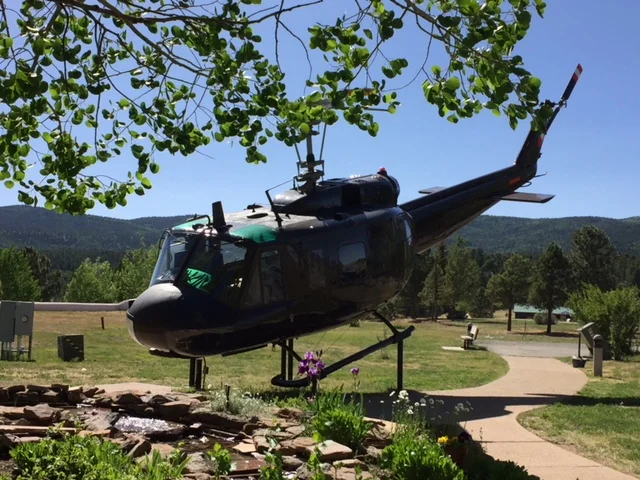Viking Surprise
Helicopter Serial Number 64-13670
Vietnam Veterans Memorial
Angel Fire, New Mexico
Friday, June 1, 2018
Clear, Windy, 95°
“If you are in trouble anywhere in the world, an airplane can fly over and drop flowers, but a helicopter can land and save your life.”
Located on a beautiful hillside in the Sangre de Cristo Mountains off Highway 64 in Angel Fire, New Mexico is the nation’s first Vietnam Veterans Memorial Park.
It was started by a father and mother of a fallen soldier. Victor and Jeanne Westphall were grief stricken when their son, David was killed in action during an ambush on May 22, 1968 that also killed sixteen young men in his unit. The Memorial started out being named the “Peace and Brotherhood Chapel” on the hillside overlooking the Moreno Valley.
I posted already telling the story of the Vietnam Veterans Memorial but I wanted to give some information and background for the UH-1D Huey Helicopter on display at this impressive site that pays tribute to those living and dead from the Vietnam conflict many years ago.
Viking Surprise
Helicopter Serial Number 64-13670 rolled off the Bell Helicopter Assembly line in 1964 and was sent to Southeast Asia during the Vietnam War. After its arrival in country it was given the nickname, Viking Surprise to those who flew her and was welcomed upon her arrival to a Landing Zone (LZ) any time.
UH-1D (Huey) Specifications
Tallest Point: 14’5” Main Rotor length: 48 feet
Range: 300 miles Empty weight: 5,000# Crew: 2 Pilots, door gunner, crew chief
Seating capacity: 8-10 troops/6 stretchers +1 medic depending on how configured
Side View
The role of the Huey in Vietnam
The Bell Iroquois UH-1 (AKA Huey) was the most widely used helicopter in the world, and its service in Vietnam makes it the most recognized.
During the Vietnam War, helicopters evolved into an essential asset on the battlefield. Due to their mobility, Hueys took the place of the traditional horse cavalry rifle troops and were re-designated as the Air Cavalry.
Huey Tail
Their missions included troop transport, air assault, and medical evacuation. Medevac made it possible for wounded soldiers to be transferred to nearby hospitals quickly, dramatically increasing their chances for survival.
Pilot seat and controls (Notice POW bracelet on cyclic control)
During the Vietnam era remarkable advances in aviation took place where pilots “pushed the envelope” to develop amazing flying skills. On 19 March 1967 while this Huey # 64-13670 was assigned to the 121st Assault Helicopter Company (AHC), an experimental smoke apparatus was installed. Smoke was produced from a ring of nozzles around the turbine exhaust using a reservoir of oil. This was one of the first of many Hueys to be outfitted as a smoke ship. This aircraft was nicknamed the “Viking Surprise”.
Close up of POW bracelet on Cyclic control
Smoke ships were used to provide cover for ground operations. When troops were inserted into LZs, the smoke ship flew in first to lay down a smoke screen around the LZ. Then, a pair of gunships would follow them to clear the area for the other helicopters to land. Finally, additional Hueys carrying troops would have up to five minutes to unload the troops and possibly reload the wounded if the wind & weather conditions were favorable.
The Battle of Easter Sunday, 1967
On Easter Sunday, 26 March 1967 at LZ Alpha near the village of Hoa Binh in the Vinh Long Province, two battalions were ambushed and a Huey was shot down. The companies sent in to secure the LZ were pinned down; all troops needed immediate evacuation.
Chief Warrant Officer (CW2) Jerry Daly and a brand new Warrant Officer (WO) flew the Viking Surprise to Vinh Long to refuel and wait for the rescue effort to get organized. Daly and his friend and veteran pilot, WO Larry McDonald, linked up in Vinh Long and the new WO was bumped from the flight. McDonald then used his flight helmet and equipment for the rescue mission. Daly radioed the 175th AHC who was organizing the rescue effort, and said, “I think I have something you can use,” referring to the smoke ship. As Maverick gunships set up a large daisy chain around the LZ, the Viking Surprise smoked the tree line, allowing four other Hueys to land and rescue the stranded troops.
The wind was strong enough to dissipate the smoke cover, so pilots Daly and McDonald had to make multiple passes, flying as low as 50 feet above the tree line to lay down additional smoke. During the battle of Easter Sunday, 13 helicopters were damaged and one crashed on the way back to base. McDonald estimated that the Surprise made 12-13 passes; they ran out of oil just as the 4th rescue copter departed the LZ. The Viking Surprise was badly damaged so it was rebuilt on the USS Corpus Christi Bay. During the inspection it was discovered that the Surprise was riddled with 135 bullet holes, six of which had gone through the pilot’s compartment.
Cockpit
After the rebuild was completed, the Viking Surprise returned to duty in Vietnam and was assigned to the 118th AHC for another 9 months. Later, it came back to the USA where it was stored until 1976 when it was acquired by the Arizona National Guard.
Looking up through windows at rotor mast
Eventually it was transferred to the New Mexico National Guard. (Information from the Vietnam Veterans Memorial at Angel Fire, NM)
In 1999, the New Mexico National Guard donated the Viking Surprise to the Vietnam Veterans Memorial at Angel Fire where it has a place of honor on this hallowed hilltop.







